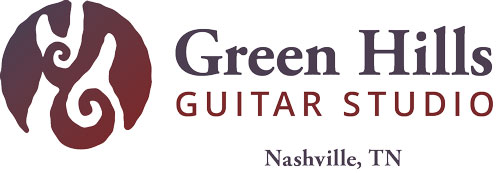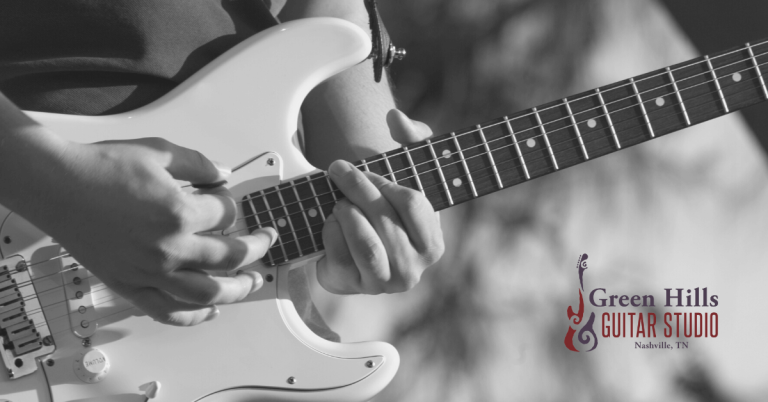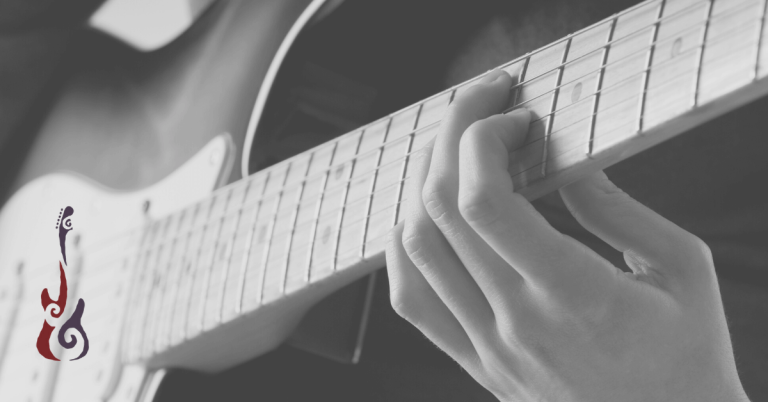Harmonic Foundation: Why Every Guitarist Should Learn Triads
Neglecting to learn triads can lead to frustrations and roadblocks in guitar playing. It’s one of the most fundamental yet often overlooked concepts by guitar players.
Without a solid understanding of triads, guitarists may struggle to create cohesive melodies, construct smooth chord progressions, and improvise effectively.
However, learning and mastering triads can significantly elevate your playing, providing clarity and direction, whether you’re a beginner or an advanced musician.
How To Learn Triads: Understanding Harmonic Structures
Harmony is the backbone of music theory, and triads are the building blocks of harmony. With this foundation, guitarists can easily find themselves able to progress beyond basic chords or able to create exciting and dynamic music. Mastering triads addresses these pain points by:
- Enhancing Melodies: Learn triads to craft better melodies with a deeper understanding of note relationships.
- Smooth Voice Leading: Learn triads to connect chords smoothly, leading to more professional-sounding voice leading.
- Improvisation Skills: Learn triads for more creative improvisation and easily navigate the fretboard.
- Playing by Ear: Learn triads to improve your ability to recognize and reproduce chord progressions, making learning new songs and adapting to different musical styles easier.
Learning triads is crucial to overcoming common challenges and achieving greater musical freedom and expression on the guitar.
What is a Triad?
A triad is a basic chord consisting of three notes: the root, the third, and the fifth. The root is the foundational note that gives the chord its name. The third, whether major or minor, determines the chord’s quality (whether it sounds happy or sad). The fifth provides stability and completeness to the chord.
Major, Minor, Diminished, and Augmented Triads
There are four main types of triads, each with its unique sound and function. Regardless of the type of triad, triads are built by stacking thirds. The difference lies in the quality of the 3rd and 5th scale degrees.
Major Triad:
Consists of a root, a major third, and a perfect fifth. It has a bright and happy sound. To construct a major triad, start with the root note. Count four half-steps (or two whole steps) from the root to find the major third. Then, count up three half-steps (or one and a half whole steps) from the major third to find the perfect fifth.
- C Major Triad: Starting with C (root), move up to E (major third), then up to G (perfect fifth).
Minor Triad:
Consists of a root, a minor third, and a perfect fifth. It has a darker, sadder sound. To construct a minor triad, start with the root note. From the root, count up three half-steps (or one and a half whole steps) to find the minor third. Then, count four half-steps (or two whole steps) from the minor third to find the perfect fifth.
- A Minor Triad: Starting with A (root), move up to C (minor third), then up to E (perfect fifth).
Diminished Triad
Consists of a root, a minor third, and a diminished fifth. It has a tense and unstable sound. To construct a diminished triad, start with the root note. From the root, count up three half-steps to find the minor third. Then, count three more half-steps from the minor third to see the diminished fifth.
- B Diminished Triad: Starting with B (root), move up to D (minor third), then up to F (diminished fifth).
Augmented Triad
Consists of a root, a major third, and an augmented fifth. It has a mysterious and unresolved sound. To construct an augmented triad, start with the root note. From the root, count up four half-steps to find the major third. Then, count four more half-steps from the major third to see the augmented fifth.
- G Augmented Triad: Starting with G (root), move up to B (major third), then up to D# (augmented fifth).
By mastering these four types of triads, guitarists can significantly expand their harmonic vocabulary, allowing for more versatile and expressive playing.
To learn these shapes and more, check out our Music Theory 1 course!
The Concept of Consonance and Dissonance
- Consonance: Triads create a sense of stability and pleasantness in music. Major and minor triads, in particular, are considered consonant and are commonly used in many musical genres.
- Dissonance: Diminished and augmented triads create tension and are considered dissonant. They are often used in music to build suspense and lead to resolution.
By understanding consonance and dissonance, guitarists can use triads to evoke different emotions and moods.
Practical Applications of Triads
Triads are not just theoretical constructs but essential tools that can significantly enhance your guitar playing. Here’s how you can practically apply triads to improve your skills:
Chord Inversions
Understanding and using chord inversions is crucial for adding variety and smoothness to your chord progressions. Inversions allow for smoother voice leading and reduce intervallic distances between chords. Good voice leading adds interest to your music!
Triads can be rearranged into different positions, known as inversions:
- First Inversion: Move the third of the triad to the bass position. Example: The C major triad (C-E-G) in the first inversion becomes E-G-C.
- Second Inversion: Move the fifth of the triad to the bass position. Example: The C major triad (C-E-G) in the second inversion becomes G-C-E.
Voice Leading
Voice leading involves transitioning smoothly from one chord to the next by minimizing the movement of individual notes. Triads are particularly effective because they often share common tones between adjacent chords. Mastering voice leading with triads can make your chord progressions sound more professional and connected.
Arpeggios
Arpeggios are a great way to add melodic interest to your playing. By turning triads into arpeggios, you can create flowing and expressive passages that enhance your melodies. Experiment with rhythmic patterns and variations to create dynamic and engaging arpeggio sequences.
Soloing and Improvisation
Triads provide a solid foundation for improvisation. You can use triadic shapes and patterns on the fretboard to navigate through chord changes and create melodic lines.
Triadic Shapes and Patterns on the Fretboard:
Explore the CAGED system and other positional approaches to visualize triadic shapes in different regions of the fretboard. This knowledge will help you navigate chord progressions and create smooth, engaging solos.
Incorporating these practical applications of triads into your practice routine will significantly enhance your guitar playing abilities. Whether strumming chords, creating melodic lines, or improvising over complex chord progressions, triads provide a versatile toolkit that can be applied across various musical genres and styles.
Creating Harmonic Extensions with Triads
Harmonic extensions involve adding notes to basic triads to form more complex chords, such as the 7th, 9th, 11th, and 13th chords. These extensions add depth and color to the harmony, enriching the overall sound.
- 7th Chords: Add the 7th note from the scale to the triad
- 9th Chords: Add the 9th note from the scale to the triad
- 11th Chords: Add the 11th note from the scale to the triad
- 13th Chords: Add the 13th note from the scale to the triad
How Triads Serve as the Foundation for Extended Chords:
Triads form the core structure of these extended chords. For example, a C major triad (C-E-G) becomes a Cmaj7 chord (C-E-G-B) when the 7th note (B) is added. To build extended chords, start with a triad and add the appropriate extensions:
Major Triad Extensions:
- C major triad (C-E-G) + 7th = Cmaj7 (C-E-G-B)
- C major triad (C-E-G) + 9th = Cmaj9 (C-E-G-D)
- C major triad (C-E-G) + 4th = Csus4 (C-E-G-F)
- C major triad (C-E-G) + 6th = Cmaj6 (C-E-G-A)
Minor Triad Extensions:
- A minor triad (A-C-E) + 7th = Am7 (A-C-E-G)
- A minor triad (A-C-E) + 9th = Am9 (A-C-E-G-B)
- A minor triad (A-C-E) + 11th = Am11 (A-C-E-G-B-D)
- A minor triad (A-C-E) + 13th = Am13 (A-C-E-G-B-D-F)
Dominant Triad Extensions:
- G major triad (G-B-D) + 7th = G7 (G-B-D-F)
- G major triad (G-B-D) + 9th = G9 (G-B-D-F-A)
- G major triad (G-B-D) + 11th = G11 (G-B-D-F-A-C)
- G major triad (G-B-D) + 13th = G13 (G-B-D-F-A-C-E)
By understanding these distinctions, guitarists can accurately construct and use extended chords to enrich their harmonic vocabulary, providing greater depth and complexity to their music.
Practical Use of Extended Chords in Music
Harmonic extensions add sophistication and richness to chord progressions, making them more exciting and emotionally engaging. For instance, a simple ii-V-I progression in C major can be transformed by using extended chords like Dm9 (ii) – G13 (V) – C6/9 (I), adding a layer of depth and color to the harmony.
Examples:
- Standard Progression: Dm – G – C
- Extended Progression: Dm9 – G13 – C6/9
Genres and Applications:
- Jazz: Utilizing 9ths, 11ths, and 13ths to enrich ii-V-I progressions.
- R&B: Adding 7ths and 9ths to basic triads for a smoother, more sophisticated sound.
- Contemporary Classical: Employing extended chords to explore complex harmonic landscapes.
By understanding and applying these concepts, you can use triads to create richer harmonies, elevating your guitar playing and musical expression. Whether you’re composing, arranging, or improvising, harmonic extensions enable you to create compelling music.
The Coda: Learn Triads To Elevate Your Guitar Playing
Practicing triads is essential for every guitarist seeking to elevate their playing. Neglecting these fundamental building blocks can lead to frustration and creative roadblocks. By understanding and learning triads, you enhance your ability to:
- Craft engaging melodies with a deeper understanding of note relationships.
- Connect chords smoothly, creating professional-sounding progressions.
- Navigate the fretboard with confidence and creativity in improvisation.
- Recognize and reproduce chord progressions by ear, making it easier to learn new songs and adapt to different musical styles.
Private Guitar Lessons in Nashville or Online
Ready to take your guitar playing to the next level? Whether you’re in Nashville or prefer online guitar lessons, Green Hills Guitar Studio offers personalized guitar instruction tailored to your needs. Our experienced instructors will help you master triads and beyond, unlocking your full musical potential.
Contact Green Hills Guitar Studio today to schedule your private guitar lessons and start your journey toward becoming a more versatile and skilled guitarist.






